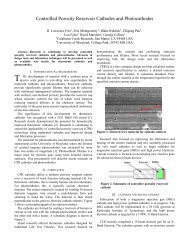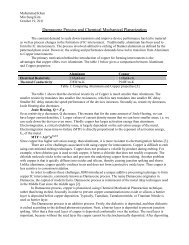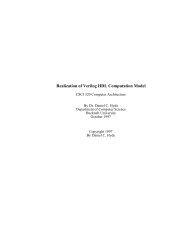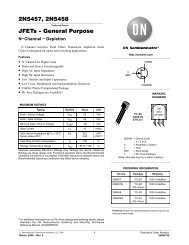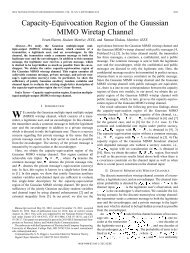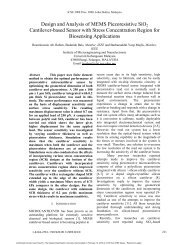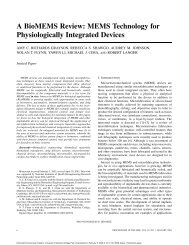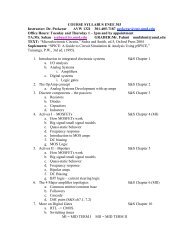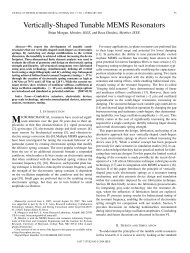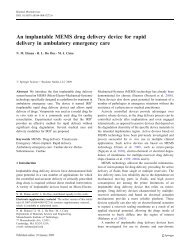Fall 2011 - ECE - University of Maryland
Fall 2011 - ECE - University of Maryland
Fall 2011 - ECE - University of Maryland
Create successful ePaper yourself
Turn your PDF publications into a flip-book with our unique Google optimized e-Paper software.
SPECIAL FEATURE<br />
Traveling Engineer: Visiting Michael Faraday<br />
by Pr<strong>of</strong>essor Emeritus Len Taylor<br />
Astonishingly, the door was partially<br />
ajar, so I just stepped inside! Many<br />
other times on Albemarle Street in<br />
central London, the doors to the<br />
Royal Institution had been locked,<br />
and my repeated knocking went<br />
unanswered. Now, across a small<br />
vestibule a wide wooden stairway<br />
lead to the basement and a sign read,<br />
“Faraday Museum”. With no one<br />
in sight, I tucked my camera away,<br />
and went down to the birthplace <strong>of</strong><br />
Electrical Engineering: the laboratory<br />
where Michael Faraday had worked.<br />
At the bottom <strong>of</strong> the stairs,<br />
pretending to be at ease, I was ignored<br />
by two men in lab coats. Another sign<br />
led me into the small s<strong>of</strong>tly-lit rooms which<br />
Faraday had occupied for four decades. I was<br />
alone for the entirety <strong>of</strong> my visit.<br />
Michael Faraday’s life story is a sort<br />
<strong>of</strong> rags-to-riches chronicle. In 1812, the<br />
poor printer’s apprentice attended public<br />
lectures by the great scientist <strong>of</strong> the era, Sir<br />
Humphry Davy. Inspired, he sent Davy<br />
his notes; requested a job; ; was accepted<br />
after a long delay became Davy’s assistant;<br />
and then rose, upon Davy’s retirement, to<br />
become director <strong>of</strong> the laboratory and a<br />
renowned scientist.<br />
There is much more to the story.<br />
Faraday was treated scornfully by Davy’s<br />
patrician wife. Then Davy, who had been<br />
knighted and made a baronet, had his own<br />
class-conscious ambitions and pr<strong>of</strong>essional<br />
jealousies. He became Faraday’s enemy,<br />
accusing him <strong>of</strong> plagiarism and for a long<br />
while succeeded in blocking his election to<br />
the Royal Society. But Faraday persevered,<br />
refusing other appointments and a<br />
knighthood, working in this basement.<br />
Clear <strong>of</strong> the work benches and lab<br />
tables that once filled them, the rooms were<br />
now lined with glass cabinets featuring<br />
enlarged images <strong>of</strong> Faraday’s handwritten<br />
lab notes. Shelves displayed experimental<br />
apparatuses that had darkened and<br />
crumbled with age, although they had<br />
been carefully made and even designed<br />
to be attractive. I supposed they were<br />
used for demonstrations in Faraday’s<br />
THE INNOVATION AND INGENUITY OF MICHAEL FARADY<br />
required presentations during the public<br />
subscription lecture series at the Institution.<br />
Two exhibits attracted my attention—<br />
they represented experiments that I always<br />
taught in undergraduate electromagnetics.<br />
The “Faraday disk” experiment showcased<br />
a copper disk which rotated between the<br />
poles <strong>of</strong> a magnet to produce an electric<br />
potential between the center and the rim,<br />
creating the first (homopolar) generator<br />
and the progenitor <strong>of</strong> modern electrical<br />
generators. Its descendants turned the 19th<br />
Century into the “Age <strong>of</strong> Electricity.”<br />
The second exhibit contained<br />
the hollow conducting and dielectric<br />
hemispheres that led Faraday to postulate<br />
the existence <strong>of</strong> an electric induction field.<br />
The metal hemispheres were only a few<br />
inches in diameter. I had to mentally<br />
resolve how they could have been so exactly<br />
made using the lathes available at that<br />
time. And what about the hollow dielectric<br />
hemispheres? (The first plastic was still<br />
decades in the future.) These seemed<br />
beautifully made <strong>of</strong> wood, wax, and a black<br />
resin, like pitch. A small object in front <strong>of</strong><br />
the spheres attracted my attention: I took<br />
it to be a gold-leaf electroscope, a primitive<br />
instrument to measure electric charge by<br />
the repulsion <strong>of</strong> the leaves.<br />
Faraday inveighed against the pollution<br />
<strong>of</strong> the Thames River, refused to participate<br />
in the development <strong>of</strong> poison gases, and<br />
argued against the quackery <strong>of</strong> his times. A<br />
deeply religious Protestant, Faraday’s beliefs<br />
have been cited by modern antievolutionists<br />
as pro<strong>of</strong> that great<br />
scientists rejected Darwin’s theory,<br />
the most significant issue <strong>of</strong> the<br />
Victorian era. However, they<br />
seem unable to cite any specific<br />
statements to support that claim.<br />
Faraday did say, “I have never seen<br />
anything incompatible between<br />
those things <strong>of</strong> man which can be<br />
known by the spirit <strong>of</strong> man which<br />
is within him and those higher<br />
things concerning his future,<br />
which he cannot know by that<br />
spirit.”<br />
Faraday died in 1867,<br />
possibly from lead poisoning incurred<br />
during his electro-chemical experiments.<br />
He played a leading role in the formation<br />
<strong>of</strong> the electrochemical industries that<br />
appeared in England during his lifetime<br />
and is considered the founder <strong>of</strong><br />
electrochemistry. Some <strong>of</strong> my forebears<br />
worked in the electroplating industry:<br />
“That’s a connection,” I thought as I left<br />
the museum.<br />
Walking back to our hotel, I tried<br />
to imagine those basement rooms in the<br />
early 19th Century. They were surely<br />
darker, colder, dirtier, and cluttered with<br />
laboratory benches and equipment, far<br />
different from the shrine-like museum.<br />
Still, I felt that I had visited Michael<br />
Faraday: he had just happened to be away<br />
from the <strong>of</strong>fice at the time. C<br />
______________________<br />
Len Taylor has been a faculty member at<br />
the <strong>University</strong> <strong>of</strong> <strong>Maryland</strong> since 1967 and<br />
has been a pioneer in the field <strong>of</strong> medical<br />
technology. He is now a Pr<strong>of</strong>essor Emeritus<br />
but is still actively teaching in the department.<br />
He is the author <strong>of</strong> over 150 journal articles<br />
and conference papers, has had 48 funded<br />
research grants, contracts and projects, and<br />
holds six U.S. and 16 foreign patents. He is<br />
a life fellow <strong>of</strong> the IEEE and <strong>of</strong> the American<br />
Society for Laser Surgery and Medicine and<br />
has been a Distinguished Lecturer <strong>of</strong> the IEEE<br />
Engineering in Medicine and Biology Society.<br />
13



